In This Issue:
by Gordon Bryson, Lone Star Fly Fishers
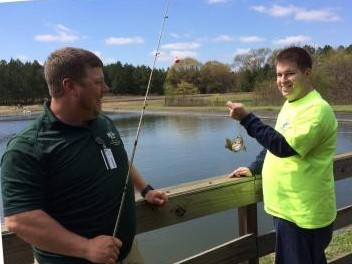
Inclusive recreation programs are a win-win for everyone involved. This has certainly, been proven by two groups of people in East Texas who came together to foster a partnership that opened the world of fishing to one group and produced both an enjoyable teaching and mentoring opportunity to the other.
Breckenridge Village of Tyler (BVT) residents is the first group. BVT is part of Baptist Child & Family Services’ global system of health and human service non-profit organizations; it is a faith-based community for adults with mild to moderate intellectual and developmental disabilities. Located on a tranquil 70-acre campus just west of Tyler, the community offers exceptional residential and day enrichment programs to empower those in their care to develop spiritually, physically, mentally, emotionally, and socially. Included on the rolling hills campus is a three-acre pond that had been stocked with bluegills and channel catfish. However, no one had been fishing it and the BVT staff was looking for a way to introduce residents to fishing safely. When Johnny Martinez, a TPWD Area Chief, fly fishing guide and member of Lone Star Fly Fishers, joined the BVT staff they soon approached him with their idea. Things were soon to change.
The second group, Lone Star Fly Fishers, is a premier non-profit membership organization for all freshwater and saltwater fly fishermen, women and children of all skill levels. The club is dedicated to offering high quality educational programs for the continued development of fly fishing and fly tying knowledge and skills. Several members of the club are certified TPWD Angler Education Instructors and are always on the lookout for teaching opportunities. Johnny Martinez saw a way for LSFF members to participate and help BVT with this project.
Working with BVT staff and LSFF members, Johnny organized the first joint fishing venture on campus at the BVT pond in August of 2018. Several members from LSFF met the group and were assigned fishing partners with eager residents who they soon learned had never fished before. Spinning outfits fitted with Zebco reels were soon baited and a few quick casting tips and tries resulted in the pond being covered with bright red and white bobbers. It didn’t take long before the first fish was reeled in to the delight of the catcher and adjacent friends. Size and species were of no factor as bluegill as small as 3 inches and channel catfish up to 18 inches were caught by all anglers. Photographs for lasting memories were made and after a couple of hours all agreed this was really fun and more should be scheduled!
Two more successful events were carried out in October and November and a new group of fisher persons was growing rapidly. A trip to the Texas Freshwater Fishery Center in Athens for winter trout was cancelled due to bad weather so it was back to warm water species. The most recent trip in July was so successful the fishing zeal of the BVT residents has reached a new level. And the LSFF members were finding realization in the quotation from Henry David Thoreau that “some men fish all their lives without knowing it is not the fish they are after.”
|
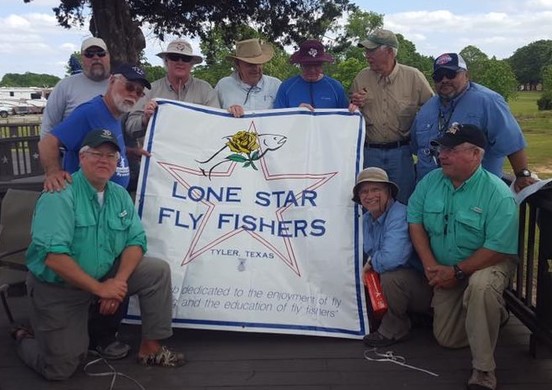 |
(Top Image: BVT staff and resident catch a fish and a smile. Photo courtesy of BVT Facebook page; Bottom image: Lone Star Fly Fishers Club members. Photo courtesy of LSFF Facebook page.)
Back to Top
by Stacy Holt, TPWD Area Chief

Backyard Bass (BYB) is probably the most exciting activity at the TPWD trailer and other events. Kids, as well as adults, love to try their hand at casting. There is a great resource under the Angler Education resources page for certified instructors planning and running a BYB activity. This article gives you additional hints and tips for running a safe and successful BYB activity.
In the setup, be thinking logistically of where your boundaries will be and mark them to keep the audience at a safe distance. Make sure that when the kids over cast (and believe me some TRY HARD!) that they will not snag trees, bushes, fences, and other obstacles. A good rule of thumb is ten yards past the end of your fish placement. Sometimes, you are forced to deal with immovable obstacles at the end of the casting area. In these cases, you can let out enough line to reach the end of the boundary, then open the Spincast reel and make a backward loop with the line around the arbor to stop it at that point. The casts will be limited to the given area.
Cones are a great way to delimit your area as well as set where the waiting line enters to cast. If you don't have hula hoops for them to stand in while casting, you can also use a cone to help the participant have a reference of where to stand and the cone can be a rod holder when not casting.
Another handy tip is to have one or two extra rods set aside in case a rod in use fails or needs extra attention. When you set aside the rods, break them apart if they are the two-piece rods. This way you don't have to keep an eye on them since they will be like magnets, attracting curious children who want to play with them.
With very young children who need extra hands-on help, Aquatic Education Specialist Keira Quam has a great tip: try to have a foot stool handy. Instead of bending over to help, you can use the stool to sit while you help the little ones cast. After a few hours, your back will thank you. Do not, however, allow kids to stand on stools. They might fall and injure themselves.
Area Chief Terry Smith has a great idea to label two or three BYB fish with shark pictures or some special identifier. Anyone who catches them gets a small prize. Kids will love the challenge and it will help to work on their aim.
Finally, when you anticipate a large crowd, try to cycle the participants through as quick as you can while giving them a great experience. If the line is full of antsy kids (and parents), let the participant catch only one fish and then on to the next person in line. If after two or three casts the child has not snagged a fish, you might want to help them by holding and guiding the rod, to keep things moving. Kids who want to have another try can get back in line, and the line will move faster.
Hope these tips help you have a great event.
(Image: Stacy Holt helps a young angler reel in a Backyard Bass. Photo by Adam Comer, TPWD.)
|
Back to Top
PROGRAM UPDATES
by Karen Marks, Aquatic Education Manager
The roaring twenties are back! The new year always gives us a time to reflect on the past and look forward to the future. In the 1920’s, jazz music became popular, women obtained the right to vote, hi-tech contraptions like telephones, motion pictures and household electricity became more common place.
In 1923, Texas Governor Pat Neff created the Texas State Parks Board. In his 1925 speech, Neff notes that "pioneers have rarely recognized the value of play," but a parks system would afford a place where people "might go and forget the anxiety and strife and vexation of life's daily grind."
By the end of the 1920’s, six fish hatcheries were also in operation in Texas, with the biggest success in the production of black bass and sunfish. Most of the reservoirs in Texas that we now frequent for fishing and boating recreation had not been created yet -- those came about mid-century due to the 1950’s drought. You can read more about the history of TPWD on the Texas State Library and Archives webpage.
Although the hi-tech scene has greatly advanced since the 1920's and most of us walk around with a small computer (aka cell phone) in our pocket, we are still looking for a place to relax and get away from life’s daily grind and that may include fishing. Thankfully, there are also many people who enjoy sharing their passion of the outdoors and fishing with others.
Thanks to the dedication of our steadfast Angler Education volunteer network, the Angler Education Program has steadily grown during the past ten years. With your help, we look forward to introducing or re-introducing youth and adults to the great outdoors and fishing in the next ten years.
What’s new for this year? We have updated our supply order forms (dated 01/2020) to include a couple of new items that you can order for your classes and events: the Outdoor Annual App card and a Fishing Tips rack card. We have also restocked the reusable Mesh Bags for waterway clean-ups. Certified instructors can find the Angler Education Supply Catalog and the new supply order forms on the Instructor's Resource page.
As you set your goals for the coming year, don’t forget that if you report 100 or more hours, you will receive a 100 Hour lapel pin next year.
If your goal is to step up your volunteer service, consider becoming an Area Chief volunteer trainer-the-trainer. Current instructors who have volunteered 25 or more hours, report online and have taken the lead for at least one class or event are eligible to attend the training which will be held in Austin on June 5-6, 2020. Contact your regional TPWD trainer if you are interested.
We wish you the best as you start your new spin around the sun.
Back to Top
by Lydia Pagel, TPWD Franklin Mountains State Park Interpreter and certified Angler Ed. Instructor
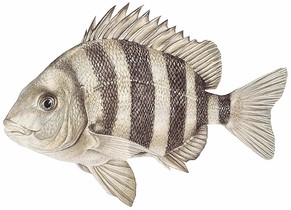
What is a fish? Ask kids and you could get a variety of answers: “slimy things,” “lives in water,” “scales and fins.” Older students may come up with “vertebrate,” “egg-laying,” or “cold-blooded.” But fish biologists (aka ichthyologists) have other terms for our favorite oviparous ectotherms and I have to admit, they don’t always roll off the tongue.
While teaching at an environmental education center, I learned a little song to help kids get familiar with the enigmatic world of ichthyology and add kinetic and oral learning to a lesson. Use the tune to “head, shoulders, knees, and toes” for this exercise, but insert the anatomical terms for fins and other identifying features like this:
Dorsal, pectoral, pelvic, caudal, pelvic, caudal. (X2)
Lateral line, operculum, and gills.
Dorsal, pectoral, pelvic, caudal, pelvic, caudal.
(And don’t forget the anal fin!)
Start with your hands together over your head to represent the dorsal fin. For the pectoral fin, stick your hands out at your arm pits. Then move your hands down to your hips for the pelvic fin. Finally, bend over and cross your arms to make a caudal fin. When it is time to demonstrate a lateral line, run your fingers down your sides. For the operculum, flap your hands at your cheeks like you’re pushing water through gills. For gills, put your hands up to their opposite cheek and wiggle your fingers. At the end of the song we always yell out “and don’t forget the anal fin!” Some naturalists put their hands to their lower back to represent the anal fin, but I was never satisfied with the anatomical inaccuracy of this method. No child of any age ever forgets the anal fin anyways.
This little jingle may not make it easier for kids to pronounce “oh-pur-kyuh-luh m,” but it serves as a useful pneumonic. Challenge your young learners to keep up with you as you sing the song faster and faster and watch their competitive streaks come out!
Check out this video to see it being sung where I used to work at Unschooling Paradise!
(Top image: Sheepshead illustration by TPWD.)
|
Back to Top
 |
|
For those interested in reaching scout groups and other youth with fishing and/or fly fishing, Texas Parks and Wildlife is partnering with Boy Scouts of America to bring the first Certified Angler Instructor (CAI) course to Texas, March 13th – 15th at Sid Richardson Scout Ranch near Bridgeport. Registration is limited so if you are interested, sign up both with BSA and with TPWD - if you aren't already a certified instructor.
To stay up to date on all our trainings and other great fishing events and tips, remember to "Like" the Texas Parks and Wildlife - Texas Angler Educators Facebook page! We would love to see how you promote fishing!
|
Back to Top
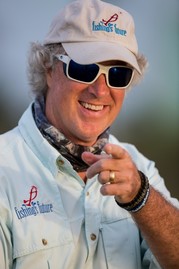
Congratulations to TPWD Angler Education Area Chief Shane Wilson who will be inducted into the Texas Freshwater Fishing Hall of Fame for 2020!
Shane Wilson is the founder of the non-profit organization, Fishing’s Future. The Texas Freshwater Fishing Hall of Fame is housed at the Texas Freshwater Fisheries Center in Athens. Its mission is to “recognize and honor those who have made a lasting contribution to freshwater fishing in Texas, and to foster a sense of appreciation, awareness and participation in the sport of fishing.” Wilson will be formally inducted into the Hall of Fame at the Texas Freshwater Fisheries Center in June 2020.
(Photo courtesy of TFFC Facebook page)
|
Thank you to all our volunteers for "Supporting the Sport” by teaching fishing in your community and for those who report volunteer hours online.
We are always excited to welcome our New Instructors and are delighted to have you join our team!
During the past fiscal year (Sept 1, 2018 – Aug 31, 2019) a total of 744 people attended an Instructor workshop. With the help of all of our wonderful and dedicated volunteers, we had another great year and reached 69,501 people at classes and events. This year, fifty Top Lures received an award pin for reporting 100 or more volunteer hours. You still have 8 months left to join the Top Lure “club” for this year!
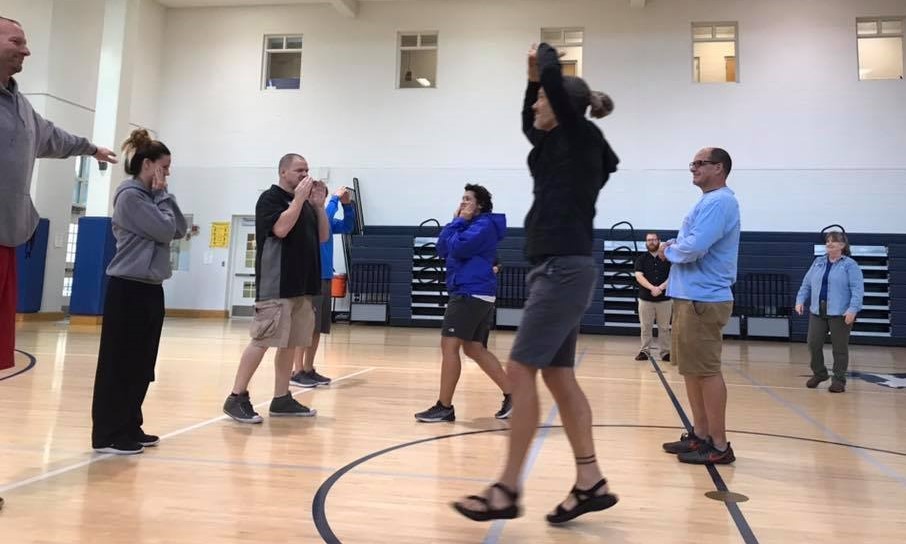 These PE Teachers at the Texas School for the Deaf learn how to teach about fish populations by playing Go Fish at a fall Instructor workshop. Check out the Go Fish activity in your Instructor Guide. (Photo by Adam Comer, TPWD.)
Back to Top
Angler Education Program | Texas Angler Educators Facebook
Learn to Fish Videos | Texas Aquatic Science | TPWD Fishing Information
Volunteer Portal | In Memoriam | Staff Contacts
Angler Education Instructor Workshops, Fishing Events, Fly Fishing Events, Texas Freshwater Fisheries Center, Sea Center Texas
|